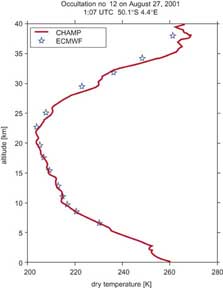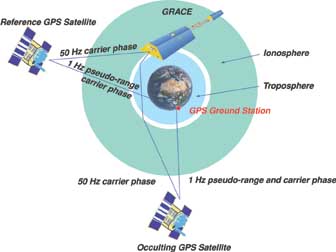
|
GRACE Publications |
|
Tracking changes in the Solid Earth GRACE data will also improve our understanding of Earth's lithosphere solid Earth. More precise measurements of the Earth's gravity field, such as those provided by GRACE, should lead to an improved understanding of the dynamics of the inner structure of the Earth.The characteristics of the continental lithosphere are the subject of varying opinions. Questions remain regarding its thermal and compositional nature, thickness, and mechanical properties. GRACE can track variations in the density of the lithosphere by looking at its impact on the Earth's gravitational field.Thus, data from GRACE will be used to compare competing models of the lower mantle viscosity and contribute to the improved understanding of mantle convection.
The graph shows a dry temperature profile derived by GeoForschungsZentrum Potsdam (GFZ) from CHAMP occultation data observed on August, 27, 2001.The corresponding meteorological analysis data from the European Centre for Medium-Range Weather Forecasts (ECMWF) is plotted for comparison. In addition to the gravity measurement, the GRACE mission will also employ an innovative new technique that uses its extremely precise Global Positioning System (GPS) receivers as atmospheric limb sounders. Limb sounding measures the excess delay of radio waves as they pass through and are bent by the Earth's atmosphere. Just as light is refracted or bends as it enters water because of the slower speed of light in the water, GPS signals are refracted as they pass through the atmosphere.The precise degree of bending (and hence the precise excess delay) is highly dependent on atmospheric pressure, temperature, and moisture content.These can all be estimated from precise observations of the changing signal delay as the GPS Satellite rises or sets.The ionosphere, which is the name applied to the ionized upper atmosphere above 100 km altitude, also affects the speed of radio waves according to the density of electrons in the ionosphere. It turns out that GPS signal distortion caused by the ionosphere varies as the radio frequency of the signal changes but that atmospheric distortions remain constant with changing radio frequency. Thus, this technique not only measures the distortion of the GPS signal but it can also distinguish how much of the observed distortion is caused by the atmosphere and how much is caused by the ionosphere. As GRACE orbits the Earth, it will use forward and aft looking antennas to measure the signals from the slower orbiting GPS satellites as they appear to rise or set behind the Earth's limb. GRACE will also measure GPS signals from higher elevation GPS satellites that are not affected by the atmosphere (illustrated in the diagram) as a standard of comparison. By observing how the GPS path delays through the atmosphere change, GRACE will create profiles of pressure, temperature, and humidity for the atmosphere and measure the variability of the ionosphere down to 100 km altitude. It is anticipated that the limb sounding technology aboard GRACE will extend and complement other spaceborne atmospheric sensors. GRACE will provide about 500 limb sounding measurements per day, unaffected by weather conditions (such as clouds and storms) that hinder or block other satellite sensors.The GRACE limb sounding measurements will be used to determine the effectiveness of limb sounding in improving numerical weather prediction in a cost effective manner.
This diagram, originally provided by GFZ, illustrates how the occultation process works. The GRACE satellite tracks a GPS satellite as it rises and sets through the limb of the atmosphere, while a second GPS serves as a reference point. GPS sounding of the continuously changing ionosphere aims to advance our understanding of the Sun's influence upon the Earth's environment, including its effects on climate, weather, radar and radio communications. Limb sounding will also be studied as a means of detecting rapid vertical changes of the Earth's surface such as volcanic explosions, earthquakes, tsunamis and other such phenomena, which are thought to cause disturbances in the ionosphere. |



